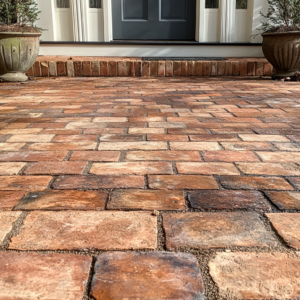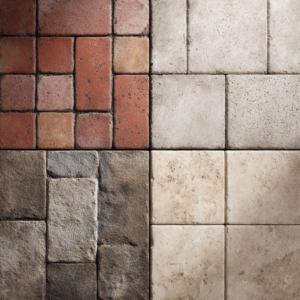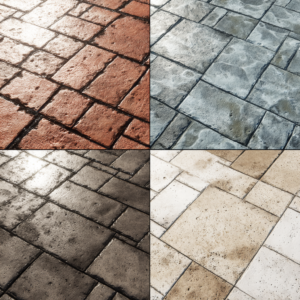In the hardscape industry, you often have tons of options of material when it comes to pavers. The most popular currently are concrete pavers, but that doesn’t mean you don’t have other options of materials, like travertine and flagstone pavers.
In this article, we are going to focus on flagstone pavers. We will clarify what exactly they are, as well as some of its pros and cons and in what occasions they should be considered as an option.
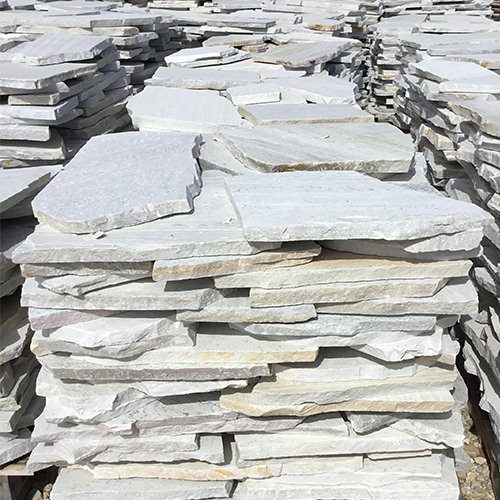
Jump to:
What are Flagstone Pavers?
Flagstone is a term used in the hardscape industry to identify a group of sedimentary rocks that can be cut and used as pavers. Amongst the most common types of flagstones are slate, limestone, sandstone, travertine and bluestone.
They are all natural, cut directly from a quarry and transported to be used as pavers. The most common colors in which you can find flagstone are a yellow-brown mixture, red and a blue-grey hue.
They are made mainly for decorative purposes and are not recommended for installations that require structural resistance.
Their uneven characteristic allows for the creation of beautiful natural patterns, but can be too chaotic for the most modern clean cut projects.
Pros and Cons of Flagstone
Starting with the pros, flagstone can bring quite a refined and unique look to your project. One of its main strengths is, after all, the aesthetic appeal.
Also, flagstone is extremely versatile. You will need a keen artistic eye to take better advantage of it, but that shouldn’t be a problem if you are creative.
They can also be quite resistance when properly cared for and cast last for years and years. Also, they are naturally slip-resistant, so they are a good choice for poolside areas.
But flagstone does come with its share of problems. Let’s talk about them.
Flagstone is a very heavy landscape material. It might be difficult to handle, even in the most optimal conditions. Installation without the help of a professional is not recommended.
With flagstone, you have a very limited choice of colors. You can occasionally find some different colors, but mostly they will stay around the reddish and light blue hues.
Maintenance is perhaps the biggest problem of flagstones. For starters, they need to be sealed regularly, more than a regular paver option. This is due to their high porous and uneven surface.
Also, although the sealer helps in protecting it, in time their colors may fade due to constant exposure to UV light.
Flagstone vs Other Options
If you absolutely require the look of stone as natural as possible in your project, understand the difficulties in maintenance, and are lucky enough to not have to worry about price, then flagstone is a good option for you.
However, if you want something more reliable, easier to maintain and work with, and cheaper, you have tons of better options.
Porcelain pavers, for example. If you are thinking long term and don’t mind paying a little more upfront for something that has the potential to last for decades, porcelain is a good choice.
They are naturally non-porous, extremely resistant and one of the easiest materials to maintain in the market. And some options can even simulate the look of natural stone!
For a more traditional choice, concrete pavers are the way to go. While you may not be able to reach that natural stone look, concrete pavers more than make up for it in sturdiness and reliability.
They are a perfect balance between a material that can last for years, but still with one of the most affordable prices available.
In fact, let’s expand a little more on the price comparison.
Flagstone prices usually range from $2 to $6 per square foot. Without accounting for installation and knowing you’ll have to expend more on future maintenance services. However, installation prices for flagstone range from $10 to $16 per square foot.
Concrete pavers on the other hand cost from $6 to $15 dollars per square foot installed.
Therefore, you will have to spend more if you want flagstone pavers.
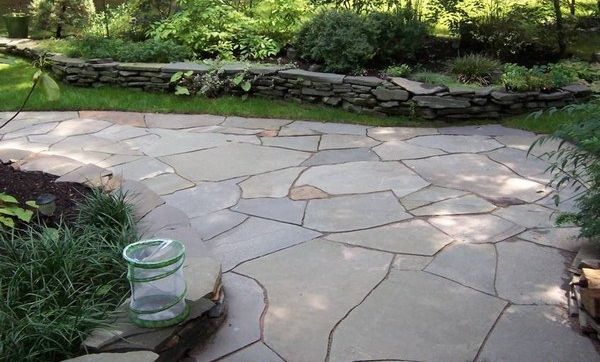
Flagstone Pavers Installation
The installation of flagstone can be a complicated matter without the help of a professional.
For starters, flagstone is heavy and difficult to move around. You cannot make positioning mistakes when working with flagstone.
Second, while other paving options are pretty straightforward and easily usable in a DIY setting, flagstone need way more planning and experience.
It is an uneven structure all around, so you cannot simply follow a predetermined pattern.
And while the natural and chaotic nature of flagstone is sought after and appreciate by many, for some homeowners it might become more of a problem.
Since it can be used in a lot of different ways, a simple general guide might not be as helpful as it would be with other paving options.
Professional Help with Flagstone Pavers
There’s no way around it. It would be irresponsible of us to tell you can do everything by yourself when it comes to flagstone.
It is a very difficult material to work with, both practically and design wise. We highly recommend you hire professionals in the hardscape area to help you with flagstone.
If you happen to be around Sarasota, in FL, we here an JS Brick would be happy to provide you with that help, both when it comes to flagstone and any other paver need you might have.
We have been providing the area for 20 years with only top quality service in the supply, maintenance and installation of paver.
Give us a call anytime at +1 941 586 9140 for a free estimate on your project.

